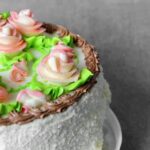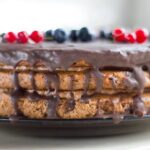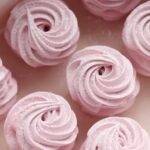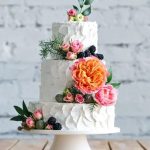Cake decorating flowers are not just simple decorations. They are intricate works of art that add beauty and significance to any cake. In recent years, there has been a growing trend in using floral decorations on cakes, with designers and bakers incorporating flowers in various creative ways. However, choosing the right flowers for cake decorating is crucial to achieve the desired effect and ensure food safety.
The beauty of cake decorating flowers lies in their ability to transform a plain cake into a stunning masterpiece. These delicate blooms can bring life and elegance to any celebration, whether it be a wedding, birthday, or special event. Each flower holds its own symbolism and meaning, making it an ideal choice for conveying emotions and adding depth to the overall design of the cake.
As more people become enchanted by the artistry of cake decorating flowers, there is a need for better understanding the different types available. This includes knowing the distinction between fresh flowers that can be used as decorations versus edible sugar flowers crafted specifically for cakes. Choosing the right type of flower depends on the desired effect, occasion, and practical considerations such as safety concerns.
In this article, we will explore the fascinating world of cake decorating flowers. We will delve into different types of flowers commonly used in cake decoration and discuss how to properly incorporate them into your designs. Whether you are an experienced baker or someone looking to try their hand at cake decoration, this comprehensive guide aims to inspire your creativity and help you achieve beautiful floral designs that will surely impress both visually and gastronomically.
Understanding the Different Types of Cake Decorating Flowers
When it comes to cake decorating, flowers are a popular choice for adding beauty, elegance, and a touch of nature to any creation. Understanding the different types of cake decorating flowers is essential in creating stunning floral designs that will impress your guests. This section will delve into the various types of flowers commonly used in cake decorating, whether they are fresh flowers or edible sugar flowers.
Fresh Flowers versus Edible Sugar Flowers
One of the first considerations when choosing cake decorating flowers is whether to use fresh flowers or edible sugar flowers. Fresh flowers offer natural beauty and fragrance, but it is crucial to ensure they are food-safe and free from pesticides. It’s recommended to use organic, pesticide-free blooms or obtain them from a trusted source that specializes in supplying safe-to-eat floral decorations.
On the other hand, edible sugar flowers offer versatility and durability. They can be made well in advance and stored easily until required. With sugar paste or gum paste as their main ingredient, these handmade creations can be molded into intricate shapes and colored to perfection. The advantage of using edible sugar flowers is that they provide exquisite detail and allow for creativity in designing unique floral arrangements.
Selecting Flowers Based on Desired Effect and Occasion
Choosing the right type of flower for your cake decoration depends on the desired effect you want to achieve and the occasion itself. Delicate blooms such as roses and peonies give off an air of romance for weddings or anniversary celebrations. Bright daisies and sunflowers create a cheerful atmosphere suitable for birthdays or summer-themed parties. Orchids and lilies evoke a sense of sophistication ideal for formal events like corporate banquets or upscale dinners.
Consider also the color palette you wish to work with when selecting cake decorating flowers. Vibrant hues may be appropriate for festive occasions while pastel shades lend themselves well to more delicate events like baby showers or afternoon teas. The key is to choose flowers that complement the overall design and theme of your cake while adding a touch of elegance and visual appeal.
Understanding the different types of cake decorating flowers will allow you to make informed choices when it comes to selecting the right blooms for your creations. Whether you opt for fresh flowers or edible sugar flowers, each has its own unique charm and benefits. By considering the desired effect and occasion, you can create stunning designs that truly showcase the artistry of cake decorating flowers.
Tips and Techniques for Incorporating Cake Decorating Flowers
Step-by-step guide on how to properly add flowers to a cake
When incorporating flowers into cake decorating, it’s important to follow certain steps for optimal results. Firstly, ensure that the flowers you choose are safe for consumption and have not been treated with pesticides or other harmful chemicals. It is best to use edible flowers or flowers specifically grown for culinary purposes.
To begin, carefully trim the stems of the flowers so that they are at a length suitable for the size of the cake and desired arrangement. It is recommended to leave about an inch or two of stem, as this will make it easier to insert them into the cake later.
Next, prepare the cake by gently pressing toothpicks or small skewers near where you want the flowers to be placed. This will act as anchors for your floral decorations.
Then, arrange your chosen blooms on top of the cake, using the toothpicks as guides and supports. It’s important to consider color combinations and placement in order to create an aesthetically pleasing design. Play around with different arrangements until you find one that best suits your vision.
Advice on prepping and arranging the flowers for optimal visual impact
Before placing the flowers on the cake, it’s essential to properly prep them. Start by removing any excess leaves or sharp thorns from stems using clean scissors or floral shears. These extra parts can detract from the overall appearance of your design and can also pose a potential hazard when consuming.
If you are working with fresh flowers, keep in mind that they may wilt if left at room temperature for too long. To help maintain their freshness and prevent wilting, cut off a small portion of each stem at an angle before placing them in cool water for hydration prior to adding them onto the cake.
For dried or preserved flower decorations, there is no need for hydration but they should still be handled delicately to avoid any damage. Dust the flowers gently with a soft paintbrush or food-safe powder to enhance their appearance and add dimension.
Tips for ensuring the flowers remain fresh and safe for consumption
To keep the flowers looking fresh on the cake, it’s important to consider a few key factors. Avoid placing them in direct contact with buttercream or other creams that could cause wilting or discoloration. Instead, insert the stems into floral tubes or wrap them in floral tape before placing them on the cake. This will help protect both the flowers and the cake from any potential contamination.
In addition, remember that some flowers may have distinct flavors or scents, which can impact the overall taste of the cake. If you’re concerned about flavor interference, you can choose to use only edible varieties of flowers that have a mild taste or opt for sugarpaste or fondant flowers instead.
Lastly, be sure to inform your guests of any edible decorations on the cake, especially if they have allergies or dietary restrictions. Provide a card or label alongside the cake indicating which portions contain edible flowers and which ones should be avoided if necessary.
By following these tips and techniques, you can confidently incorporate beautiful and delicious flower decorations onto your cakes, adding an extra touch of elegance and creativity to any special occasion.
Edible Sugar Flowers
Cake decorating is an art form that has gained immense popularity in recent years. Among the various techniques and styles, using edible sugar flowers to decorate cakes has become a masterclass in cake decoration. These delicate and realistic floral creations add a touch of elegance and sophistication to any cake design. In this section, we will delve into the process and artistry of creating edible sugar flowers, providing you with the tools, techniques, and inspiration to create stunning floral masterpieces.
To create edible sugar flowers, a combination of skill and creativity is required. The process begins by gathering the necessary tools and materials. These include flower modeling paste or gum paste, flower veiners for shaping petals, edibles dyes or petal dusts for coloring, shaping tools such as ball tools and soft foam pads, and fine brushes for adding fine details.
The first step in creating edible sugar flowers is sculpting the petals. This involves rolling out the gum paste thinly and cutting it into the desired shape using petal cutters. Each petal is then individually shaped by thinning out the edges with a ball tool or soft foam pad to achieve a natural curve. The petals are then left to dry overnight before assembling them into a flower.
Once all the petals have dried completely, they can be assembled into beautiful blooms using royal icing as glue. It is important to follow proper assembly techniques to ensure stability and realism in the final product. Additionally, adding color and depth to your sugar flowers can be achieved through various techniques such as dusting petal dusts onto the surface or airbrushing with food color sprays.
Mastering the art of creating edible sugar flowers opens up endless possibilities for your cake designs. From lifelike roses to vibrant orchids or whimsical wildflowers, these delicate creations allow you to showcase your creativity while adding an ethereal touch to your cakes.
By incorporating edible sugar flowers into your cake decoration repertoire, you can create visually stunning and unique designs that are sure to impress. The versatility of sugar flowers allows for endless customization, making them suitable for all occasions from weddings to birthdays and everything in between. So, why not explore the world of sugar flower artistry and elevate your cake decorating skills to new heights?
Popular Flower Designs
When it comes to cake decorating, floral designs have always been a popular choice. Flowers bring vibrancy, elegance, and a touch of nature to any cake, making them the perfect decorative element for various occasions. Whether you are planning a wedding, birthday party, or simply want to impress your guests with a beautiful dessert, incorporating flower designs into your cake can create a stunning visual impact.
One of the current trends in cake decorating is the use of cascading flower arrangements. This design involves arranging flowers in a way that they appear to be cascading down the sides of the cake, creating a whimsical and romantic look. Roses, peonies, and orchids are commonly used in this style as they provide a delicate and feminine touch.
Another popular flower design is the floral wreath. This design entails arranging different types of flowers in a circular shape on top of the cake. Floral wreaths are often used for spring or summer-themed cakes and can be customized based on color palette and flower selection. Sunflowers, daisies, and lavender are some common choices for this style.
For those looking for a more minimalist approach, adding small clusters of flowers as accents can create an elegant and sophisticated look. This design involves placing small groups of flowers strategically around the cake to highlight certain areas or to add pops of color. Lilies, tulips, and gardenias work well for this type of decoration.
| Flower Design | Cake Description |
|---|---|
| Cascading Roses | A three-tiered wedding cake with cascading pale pink roses that create an ethereal effect. |
| Spring Floral Wreath | A single-tiered vanilla cake with a delicate wreath made of pastel-colored daisies and baby’s breath. |
| Elegant Lily Accents | A sophisticated chocolate cake adorned with small clusters of white lilies, adding a touch of glamour. |
These are just a few examples to inspire your creativity. Ultimately, the design possibilities are endless when it comes to cake decorating with flowers. Experiment with different flower combinations, colors, and arrangements to create your own unique masterpiece.
Remember to carefully select flowers that are safe for consumption and properly prepare them for use on cakes. With a little imagination and practice, you can elevate your cake decorating skills by incorporating stunning floral designs that will wow your guests and make any occasion extra special.
Floral Cakes for Every Occasion
Floral cakes have become a popular choice for people looking to add an extra touch of elegance and beauty to their special occasions. Whether it’s a wedding, birthday, or any other celebration, incorporating cake decorating flowers can elevate the overall aesthetic and make the event even more memorable. In this section, we will explore ideas and inspiration for incorporating floral decorations into specific events and celebrations.
Ideas for Weddings
- Flower Focal Point: Create a stunning tiered cake with a beautiful arrangement of fresh flowers as the focal point. Coordinate the flower selection with the wedding theme or color palette.
- Romantic Designs: Incorporate delicate sugar flowers cascading down the tiers or trailing up from the bottom to create a romantic look.
- Floral Wreaths: Add a whimsical touch by placing miniature floral wreaths around each tier of the cake.
Ideas for Birthdays
- Bouquet Cupcakes: Decorate individual cupcakes with buttercream frosting in various colors to resemble flower bouquets. Arrange them on a cake stand to create a centerpiece.
- Floral Crown Cake Topper: Top off your birthday cake with a crown made out of edible sugar flowers for a regal and feminine touch.
- Flower Power Cake: For a fun and vibrant birthday celebration, decorate the cake with colorful sugar flowers in bold hues like pink, yellow, and orange.
No matter what occasion you are celebrating, there are endless possibilities when it comes to incorporating floral decorations into your cakes. The key is to choose flowers that match the theme or mood you want to convey.
From elegant rose arrangements on wedding cakes to cheerful sunflowers on birthday cakes, adding floral elements will surely make your celebration extra special. So go ahead and embrace the beauty of cake decorating flowers – let your imagination run wild and create breathtaking masterpieces that will leave everyone in awe.
Flower Alternatives
When it comes to cake decorating, incorporating floral elements can add elegance and charm to any design. However, for those looking for a unique twist or who want to avoid using actual flowers, there are plenty of unconventional cake decorating ideas available. These alternatives allow for creativity and personalization while still achieving a beautiful floral-inspired look.
One alternative to using real flowers is to create flower-like decorations using edible materials such as fondant or gum paste. These versatile mediums can be molded and shaped into various flower designs, allowing for endless possibilities. From delicate rose petals to vibrant sunflowers, these edible creations can add a pop of color and texture to your cake.
Another option is to use wafer paper or rice paper to create edible flower decorations. Wafer paper is thin and translucent, making it perfect for creating delicate flower petals. By cutting out different shapes, layering them together, and adding some food coloring or petal dust, you can achieve stunning and realistic-looking flowers without the need for fresh blooms.
If you’re looking for a more unconventional approach, consider using non-edible materials to create flower-like decorations on your cake. For example, you could use silk or fabric flowers that are specifically designed for cake decorating purposes. These artificial blooms come in a variety of colors and styles, allowing you to match them perfectly with your desired theme or color scheme.
Finally, you can also explore other unconventional floral designs by using techniques such as piping or painting directly onto the cake surface. With piping, you can create intricate designs that resemble flowers by using icing bags and various tips. Similarly, painting directly onto the cake allows for more artistic freedom where you can create unique floral patterns and designs that are completely one-of-a-kind.
Incorporating flower alternatives in cake decorating opens up a whole new world of creativity and possibilities. Whether you choose edible options like fondant or wafer paper, non-edible materials like silk flowers, or opt for techniques like piping or painting, there are many exciting ways to achieve a floral-inspired look without using actual flowers.
The key is to experiment, have fun, and let your imagination run wild as you create stunning and unconventional designs that will surely impress your guests.
The Dos and Don’ts of Cake Decorating with Flowers
Cake decorating with flowers can add a touch of elegance and beauty to any cake. However, it is important to follow certain guidelines to ensure that the flowers are safe for consumption and don’t compromise the overall look and taste of the cake. Here are some essential dos and don’ts to keep in mind when using flowers for cake decoration:
Do:
- Choose food-safe flowers: When selecting flowers for decorating cakes, make sure they are edible and free from pesticides or other harmful chemicals. Popular edible flowers include roses, violets, pansies, marigolds, and lavender. If you’re unsure about the safety of a specific flower, it’s best to do your research or consult with a florist.
- Clean the flowers properly: Before using fresh flowers on a cake, ensure that they are clean and free from dirt or insects. Gently wash them under cold water and pat them dry with paper towels. Remove any unwanted parts such as stems or leaves before placing them on the cake.
- Use floral tape or picks: To avoid direct contact between the flowers and the cake surface, it is recommended to wrap the stems with floral tape or insert them into floral picks before inserting them into the cake. This will help prevent any potential contamination from flower residue.
Don’t:
- Use toxic flowers: Certain types of flowers are toxic when consumed and should never be used for cake decoration. These include lilies, daffodils, tulips, hydrangeas, foxgloves, ivy, and oleander. Always research which flowers are safe before using them on a cake.
- Place flowers directly on frosting: Although it may seem tempting to simply place fresh flowers directly onto buttercream or fondant frosting, this can lead to bacterial growth or transfer of chemicals onto the cake. It’s important to create a barrier between the flowers and the cake by using floral tape or picks.
- Use non-food-safe decorations: While it may be tempting to use non-edible flowers, such as silk or plastic ones, for convenience or long-lasting effects, these should not come into direct contact with the cake. If you want to incorporate non-edible flowers into your design, place them on top of a separate platform or use them as part of a larger floral arrangement around the cake.
When using flowers for cake decorating, it’s crucial to prioritize food safety and aesthetic appeal. Following these dos and don’ts will help you achieve a stunning and delicious cake that is sure to impress both visually and in taste.
| Do | Don’t |
|---|---|
| Choose food-safe flowers | Use toxic flowers |
| Clean the flowers properly | Place flowers directly on frosting |
| Use floral tape or picks | Use non-food-safe decorations |
Conclusion
In conclusion, cake decorating flowers offer a unique and exquisite touch to any cake. The beauty and significance of these floral decorations cannot be overstated. From weddings to birthdays, incorporating flowers into cake designs adds flair and elegance, making any celebration extra special.
Whether you choose fresh flowers or edible sugar flowers, there are endless possibilities for creating stunning floral cake decorations. Understanding the different types of flowers and their effects is key in selecting the right ones for your desired outcome and occasion.
When it comes to incorporating cake decorating flowers, proper techniques and preparation are essential. By following a step-by-step guide on adding flowers to cakes, arranging them for optimal visual impact, and ensuring they remain fresh and safe for consumption, you can achieve breathtaking results.
Although traditional flower designs are popular, don’t be afraid to think outside the box with unconventional floral elements. There are alternative materials or techniques available that can create flower-like decorations without using actual flowers. Themed cakes offer another avenue for exploring unique floral designs that will surely impress.
In embracing the joys of cake decorating flowers, you open yourself up to endless creative possibilities. Whether you’re a professional baker or an amateur enthusiast, this art form provides an opportunity to showcase your talent and bring delight to others. So go ahead, explore, experiment, and unleash your creativity with cake decorating flowers – the results will undoubtedly be sweetly satisfying.
Frequently Asked Questions
What are the ideal flowers for cake decorating?
When it comes to cake decorating, the ideal flowers are those that are both visually appealing and safe for consumption. Some of the popular choices for cake decorations include roses, daisies, peonies, and sunflowers.
These flowers can add a touch of elegance and a burst of color to any cake. It is important to select flowers that are non-toxic and pesticide-free to ensure they are safe for consumption.
How to make decorative flowers for cakes?
Making decorative flowers for cakes can be a fun and creative process. There are several techniques you can use depending on the look you want to achieve. One common method is using fondant or gum paste to shape the flowers by hand or with the help of cutters and molds.
These edible mediums allow you to create intricate details and realistic textures for your floral decorations. Another option is working with buttercream frosting, where you can use piping techniques to create beautiful flower designs directly on the cake.
What fake flowers to use on cakes?
When it comes to using fake flowers on cakes, it’s important to ensure they are food-safe and non-toxic. Most artificial flowers that are specifically designed for cake decoration will mention if they are food-safe on the packaging or label.
Silk or fabric flowers should not be used on cakes as they may not be suitable for consumption. It’s always recommended to opt for artificial flowers made from food-grade materials such as sugar paste or edible wafer paper if you want long-lasting floral decorations without compromising safety and taste.

Welcome to my blog about home and family. This blog is a place where I will share my thoughts, ideas, and experiences related to these important topics. I am a stay-at-home mom with two young children. I hope you enjoy reading it! and may find some helpful tips and ideas that will make your home and family life even better!





